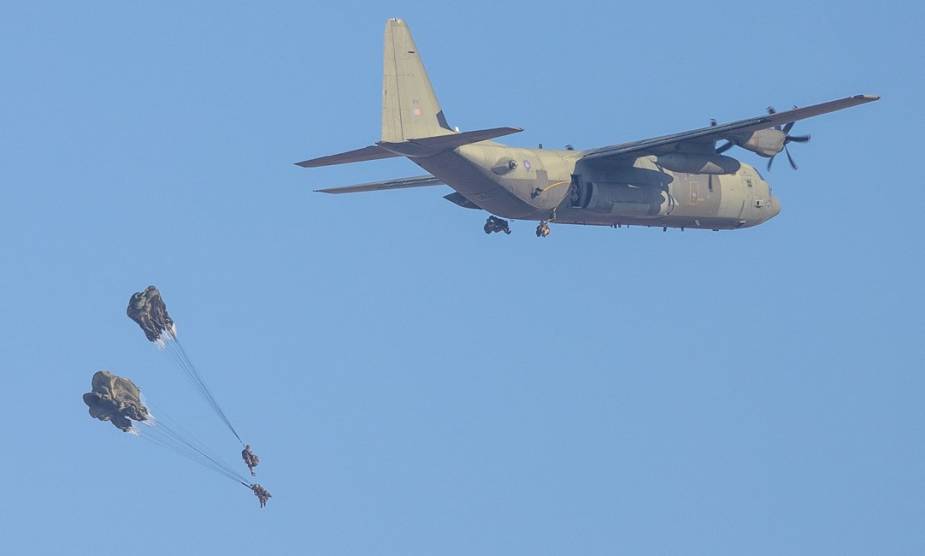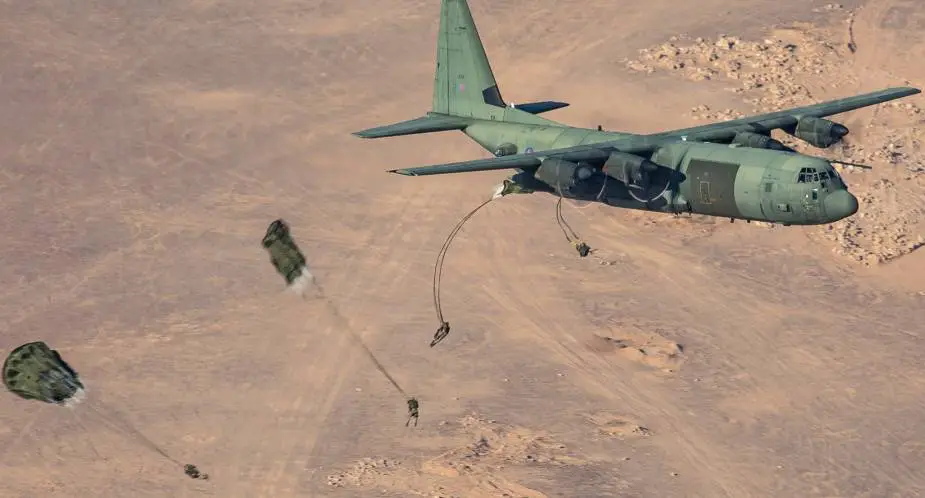More than 150 soldiers from the British Lead Assault Force (LAF) are sitting in a building of the Akrotiri air base, Greece. They have gone through their final preparations in Cyprus and have just received the green light warning order from Brigadier James Martin, Commander 16 Air Assault Brigade. The British Army reports on its website.
Follow Army Recognition on Google News at this link

The Pathfinders, trained in specialist airborne maneuver techniques and capable of conducting offensive action tasks at very short notice, have done their job. (Picture source: British Army)
What comes next is an adrenaline rush these troops know very well, is something they have trained hard for and which all fits into their raison d’etre - agile, lean, fast. “I like the build-up, the rehearsals, the kit prep and knowing you’re in good order for what’s about to come,” said Private Cameron Roberts, 22, of A Company, 2nd Battalion The Parachute Regiment, who is the number one in his mortar platoon detachment. “When you’re in the aircraft, you’re hot and in heavy kit, but when the door opens there’s a relief because you know what you’ve got to do, then you go and you do it,” said the Essex soldier, who has been with the unit four years.
2 PARA comes under 16 Air Assault Brigade, based in Colchester, and is the most deployable and ready formation in the British Army, standing as a core component of the UK’s Global Response Force. They spearhead the LAF, made up of key enablers from 7 Parachute Regiment Royal Horse Artillery, 32 Regiment Royal Artillery, 23 Parachute Engineer Regiment, 14 Signal Regiment the Royal Electrical and Mechanical Engineers, 16 Medical Regiment and 13 Air Assault Support Regiment, to complete whatever mission is thrown at them on the ground
This Joint Theatre Entry with the Jordanian Armed Forces, linking in with the Carrier Strike Group as part of Operation Fortis, is illustrative of the British Army’s more integrated and more expeditionary Future Soldier concept, ready for future challenges.
The drop zone for the LAF and Jordanians has already been established prior to the C130 insertions. The Pathfinders, trained in specialist airborne manouevre techniques and capable of conducting offensive action tasks at very short notice, have done their job.
A fire support group on the ground and the Joint Terminal Attack Controllers have ensured safe passage for the C130s, flanked by two Typhoons for air and land integration. “On landing, there’s one objective for my detachment, hit that mortar line with everything in place to support the rifle companies,” said Cameron. “When it comes to getting from one place to another to achieve effect, nobody can do it quicker than us. Because of the nature of being held at readiness, our training is designed to be ready, always. We have the equipment, skill set and personnel to meet whatever challenge comes.”
Private Zander Mouton, 28, from South Africa, has been with 2 PARA for more than two years and is part of Cameron’s mortar detachment. He said: “There’s an adrenalin effect you can’t really explain to people and it ramps up when we get the green light to go just before the door of the aircraft opens. We’re always ready to go. That’s what we do. We’ve got a very strong bond.”
Lieutenant Colonel David Middleton took over command of 2 PARA in March this year. “It’s in the soldiers’ nature to be prepared and ready for an activity like this, which is an excellent opportunity to show their capability and have real pride in performing to their very best," he said. “Agility and speed are always our watchwords and a leaner, lighter, faster force is something we embrace. For us that’s our way of operating, by arriving by aircraft into a position as quickly as possible and then being light and agile on our feet. The massing of more than 150 soldiers onto the drop zone and then moving off really quickly to conduct a tactical action is complex. I’m very confident in the individual soldiers' skills and drills. but it’s about them taking place at the right time, when I want them to do so - that’s the challenge.”
Major Drew Houston, of 7 PARA RHA, from Hertfordshire, said the JTE was an integration of specialist skill sets from across the British Army to achieve the effect. “We work to take our capability to the next stage by refining what we do and how we operate with equipment,” he said. “There’s a complex web of unit involvement in the build-up to any JTE in order to allow us to complete what’s needed in the field. There’s an extraordinary amount of talent and professionalism to get us in a solid place for that moment when we jump from the C-130s”.
Lt Col Middleton said: “I want us to be really comfortable with the way we insert at the range, strategically, from one country to another. What comes with that is low-level parachuting and then rallying very quickly, moving off and then conducting the tactical action we’ve been asked to do. “There are always complexities synchronising everything together, hone the ways you want to operate and make sure you’re as prepared as you should be for high readiness, which we now hold and then for the wider elements of 2 PARA it’s about being involved in a very rewarding activity. We are ready for anything, a global force, whether that be responding to disaster relief to operating overseas with partners and also high-end warfighting, at a moment’s notice.”

Major Drew Houston, of 7 PARA RHA: ”There’s an extraordinary amount of talent and professionalism to get us in a solid place for that moment when we jump from the C-130s”. (Picture source: British Army)














